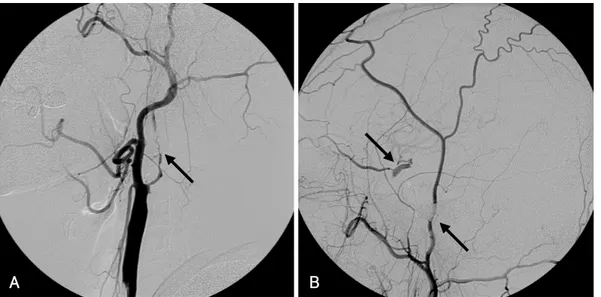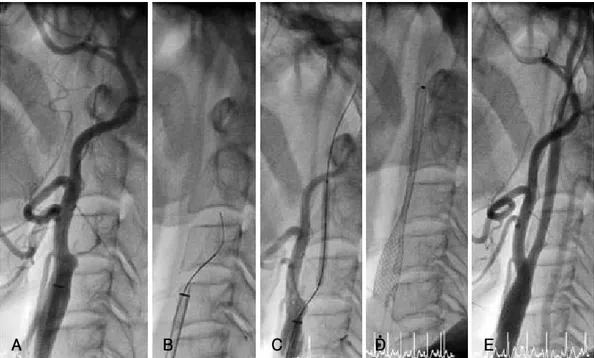288
CASE REPORT
DOI 10.4070 / kcj.2010.40.6.288
Print ISSN 1738-5520 / On-line ISSN 1738-5555 Copyright ⓒ 2010 The Korean Society of Cardiology
Open Access
Successful Carotid Stenting for Chronic Total Occlusion
of the Internal Carotid Artery
Won Ho Kim, MD1, Pil-Ki Min, MD3, Dong Jun Kim, MD2 and Won-Heum Shim, MD1
1Division of Cardiology, Yonsei Cardiovascular Hospital, 2Division of Radiology, Severance Hospital, 3Division of Cardiology, Gangnam Severance Hospital, Yonsei University College of Medicine, Seoul, Korea
ABSTRACT
A 64-year-old man complaining of pulsatile headache was admitted. Imaging studies revealed a near-total occlu-sion of the right proximal internal carotid artery (ICA) with slow antegrade flow into the distal ICA. Right cere-bral flow was supplied by collateral flow through the posterior communicating and ophthalmic arteries. He was successfully treated by carotid artery stenting. No new neurological deficit or transient ischemic attack occurred after treatment. (Korean Circ J 2010;40:288-291)
KEY WORDS: Thrombosis, internal carotid artery; Stents.
Introduction
The development of endovascular therapy has enabl-ed recanalization of chronic totally occludenabl-ed coronary and subclavian arteries.1) However, little is known about
the feasibility and safety of endovascular treatment for chronic total occlusion (CTO) of the carotid artery. We describe a case of successful stenting for a CTO of the right internal carotid artery (ICA) with cerebral hypo-perfusion.
Case
History and pre-intervention evaluation
A 64-year-old man was admitted complaining of pul-satile headache. The patient had a history of coronary artery disease and a cerebrovascular accident 2 years ago. He was ex-smoker. There was no history of diabetes, ar-rhythmia, or cardiac valvular disease. His blood pressure was normal. Auscultation of the neck showed normal
carotid upstrokes. He was alert and oriented. A detail-ed neurologic examination was normal. An electrocar-diogram showed a normal sinus rhythm. An echocar-diogram showed no cardiac embolic source.
Magnetic resonance (MR) imaging of the brain and neck showed old ischemic lesions in the bilateral centrum semiovale, left basal ganglia, and a CTO of the right ICA. Diagnostic cerebral angiograms showed a CTO of the right proximal ICA with slow antegrade flow into the distal ICA. Right cerebral flow was supplied by collateral flow through the posterior communicating and ophth-almic arteries (Fig. 1). Single-photon emission CT (SP-ECT) scanning with 99mTc-ethyl cysteinate dimmer
reveal-ed decreasreveal-ed uptake in the right cerebral hemisphere with reduced reactivity to the Diamox challenge test, sugges-tive of a decrease in vascular reserve (Fig. 2). Angioplasty was risky because there were multiple, calcified long le-sions, and stenting was technically difficult. We proposed extracranial-intracranial (EC-IC) bypass surgery, but he refused surgery. The patient suffered from pulsatile head-ache and it was refractory to medical treatment. Imag-ing studies showed definite evidence of ischemia, and the collateral flow through the posterior communicat-ing and ophthalmic arteries was insufficient. Judgcommunicat-ing from symptoms, imaging studies, and a history of CVA, we thought that endovascular recanalization was required. Endovascular procedure
A 6 French (F) sheath was introduced into the right femoral artery. A 5F diagnostic catheter was placed in
Received: September 29, 2009 Accepted: October 26, 2009
Correspondence: Won-Heum Shim, MD,Division of Cardiology, Yonsei Car -diovascular Hospital, Yonsei University College of Medicine, 250 Seongsan-ro, Seodaemun-gu, Seoul 120-752, Korea
Tel: 82-2-2228-8457, Fax: 82-2-393-2041 E-mail: whshim@yuhs.ac
This is an Open Access article distributed under the terms of the Creative Commons Attribution Non-Commercial License (http://creativecommons. org/licenses/by-nc/3.0) which permits unrestricted non-commercial use, distribution, and reproduction in any medium, provided the original work is properly cited.
Won Ho Kim, et al.·289
the right innominate artery and a 0.035-inch guidewire (Terumo Corp., Tokyo, Japan) was used to exchange a 7F Shuttle-SL guide sheath (Cook, Bloomington, IN, USA) into the right common carotid artery (CCA). He-parinization was performed during the intervention with the active clotting time being kept at about 250 to 300 seconds. The 7F Shuttle-SL guide sheath was position-ed proximal to the right common carotid bifurcation. A microcatheter was placed proximal to the occlusion to improve the backup support for the wire manipulation. While avoiding excessive rotational or drilling motion of the wire, successive small penetrate-and-advance steps were made along the imaginary tract of the occluded ves-sel segment. The lesion was crossed with a 0.014-inch guidewire, the tip of which was positioned in the middle cerebral artery. The microcatheter was exchanged for a 1.25×10 mm balloon, which was inflated to predilate
the occlusion from the distal portion of the ICA initial-ly and moved to the proximal portion of the ICA. An embolic protection device could not be used because the stenosis was very hard and the manipulation of the de-vice was technically difficult. Follow-up angiography sh-owed reduction of the stenosis and insufficient revas-cularization of the ICA. The catheter was exchanged for a 1.5×20 mm balloon, and the ICA was dilated in the same manner. Next, balloon angioplasty with a 2.5×30 mm balloon was performed at the bifurcation of the CCA. After successive balloon angioplasty, the angio-gram showed a dilated and patent ICA with narrowing at the bifurcation. A 9×50 mm self-expanding stent (Carotid Wallstent, Boston Scientific, Galway, Ireland) was placed to cover the occluded portion, followed by post-dilation to achieve a residual diameter stenosis of <20% (Fig. 3). The final angiogram showed patency of
Fig. 2. A: single-photon emission CT scanning with a 99mTc-ethyl cysteinate dimmer revealed decreased uptake in the right cerebral
he-misphere. B: scans obtained after the Diamox challenge showed no increase in cerebral flow in the right cerebral hemisphere, sugges-tive of a decrease in vascular reserve.
A B
A B
Fig. 1. A: cerebral angiography from the right CCA confirms the presence of a near-total occlusion of the right proximal ICA with slow antegrade
flow into the distal ICA (arrow). B: right cerebral flow is supplied by collateral flow through the posterior communicating (arrow) and oph-thalmic arteries (arrow), as shown on an angiogram of the extracranial artery. CCA: common carotid artery, ICA: internal carotid artery.
290·Carotid Stenting for Chronic Total Occlusion
the carotid artery, with re-established antegrade filling of the middle and anterior cerebral arteries. The revers-ed ophthalmic artery flow was normalizrevers-ed.
The patient had no neurologic changes following the procedure. Follow up SPECT revealed an increase in ce-rebral blood flow with recovery of vascular reactivity (Fig. 4). Also, MR angiography revealed complete re-canalization of the right ICA. At 30-day follow up (Fig. 5), he continued to be free of symptoms.
Discussion
There is a direct relationship between the degree of carotid artery stenosis/occlusion and the risk of
ipsila-teral stroke.1-4) Carotid artery stenting has emerged as
an alternative treatment to carotid endarterectomy for this common disorder.5-7) The SAPPHIRE investigators
reported that carotid stenting was not inferior to ca-rotid endarterectomy for the treatment of caca-rotid artery stenosis at 3 years.8)
However, CTO of the carotid artery is different. En-darterectomy prevents stroke in patients with ICA st-enosis, but the success rate in recanalizing occlusions is as low as 34% because of technical difficulties.9)
Sur-gical bypass may be a natural resolution for ICA occlu-sion, although the large international randomized EC-IC bypass trial failed to show any benefit.10) Recently,
there have been few reports of revascularization by CTO
A B C D E
Fig. 3. Endovascular treatment. A: proximal ICA occlusion. B: the wire advancing with the microcatheter. C: predilatation with a coronary
balloon. D: successful stenting insertion. E: final angiogram after carotid stent implantation after adjuvant balloon post-dilation.
A B
Fig. 4. Single-photon emission CT scanning with a 99mTc-ethyl cysteinate dimmer obtained after endovascular recanalization. A:
cere-bral blood flow at rest increased in the right frontotemporal region compared to that before treatment. B: vascular reactivity for the Dia-mox challenge also recovered.
Won Ho Kim, et al.·291
of the ICA by percutaneous angioplasty. Terada et al.1)
reported the use of angioplasty for a CTO of the cervi-cal ICA with cerebral hypoperfusion. Their study show-ed that endovascular recanalization can be performshow-ed for symptomatic ICA occlusion, even in the chronic st-age of the illness. Komiyama et al.11) demonstrated that
percutaneous angioplasty for a CTO of the intracra-nial ICA is technically feasible and can be an alterna-tive to ECIC bypass surgery in a selected group of pa-tients with symptomatic hemodynamic compromise.
Cerebral embolization occurs during all stages of ca-rotid artery stenting. Embolic protection devices (EPDs) reduced the stroke risk involved with carotid artery st-enting in analysis of the Global Carotid Artery Stent Re-gistry. The incidence of death/stroke was 6.93% with-out use of EPDs, but was 3.22% with EPDs.12) Despite
this efficacy, we could not use an EPD because of tech-nical problems.
The overall rate of subsequent stroke is 7% per year and 5.9% per year for ischemic stroke ipsilateral to the CTO of the ICA.13) These risks are higher in patients with
hemodynamic impairment.14) Recently, Kao et al.15)
de-monstrated that stenting for cervical ICA occlusion is feasible with acceptable midterm clinical results. Alth-ough this is a single case report, our case also suggests that endovascular revascularization can be performed in some patients with chronic ICA occlusions.
Conclusions
Our case shows that carotid stenting can be a success-ful alternative to EC-IC bypass surgery in patients with CTO of the ICA.
REFERENCES
1) Terada T, Yamaga H, Tsumoto T, Masuo O, Itakura T. Use of an embolic protection system during endovascular recanalization of a totally occluded cervical internal carotid artery at the chronic stage: case report. J Neurosurg 2005;102:558-64.
2) Rothwell PM, Eliasziw M, Gutnikov SA, et al. Analysis of pooled data from the randomised controlled trials of endarterectomy for symptomatic carotid stenosis. Lancet 2003;361:107-16. 3) Inzitari D, Eliasziw M, Gates P, et al. The causes and risk of stroke
in patients with asymptomatic internal-carotid-artery stenosis. N Engl J Med 2000;342:1693-700.
4) Ohki T, Parodi J, Veith FJ, et al. Efficacy of a proximal occlusion catheter with reversal of flow in the prevention of embolic events during carotid artery stenting: an experimental analysis. J Vasc Surg 2001;33:504-9.
5) European Carotid Surgery Trial. Randomised trial of endarterec-tomy for recently symptomatic carotid stenosis: final results of the MRC European Carotid Surgery Trial (ECST). Lancet 1998; 351:1379-87.
6) Roubin GS, New G, Iyer SS, et al. Immediate and late clinical outcomes of carotid artery stenting in patients with symptomatic and asymptomatic carotid artery stenosis: a 5-year prospective analysis. Circulation 2001;103:532-7.
7) Ko YG, Park SH, Kim JY, et al. Carotid artery stenting with dis-tal protection device: early experience. Korean Circ J 2005;35: 61-8.
8) Gurm HS, Yadav JS, Fayad P, et al. Long-term results of carotid stenting versus endarterectomy in high-risk patients. N Engl J Med 2008;358:1572-9.
9) Paty PSK, Adeniyi JA, Mehta M, et al. Surgical treatment of in-ternal carotid artery occlusion. J Vasc Surg 2003;37:785-8. 10) The EC-IC Bypass Study Group. Failure of
extracranial-intracra-nial arterial bypass to reduce the risk of ischemic stroke: results of an international randomized trial. N Engl J Med 1985;313: 1191-200.
11) Komiyama M, Yoshimura M, Honnda Y, Matsusaka Y, Yasui Y. Percutaneous angioplasty of a chronic total occlusion of the in-tracranial internal carotid artery: case report. Surg Neurol 2006; 66:513-8.
12) Dieter RS, Laird JR. Carotid artery stenting: update. Int J Car-diovasc Intervent 2005;7:126-33.
13) Hankey GJ, Warlow CP. Prognosis of symptomatic carotid oc-clusion: an overview. Cerebrovasc Dis 1991;1:245-56. 14) Derdeyn CP, Grubb RL Jr, Powers WJ. Cerebral hemodynamic
im-pairment: methods of measurement and association with stroke risk. Neurology 1999;53:251-9.
15) Kao HL, Lin MS, Wang CS, et al. Feasibility of endovascular re-canalization for symptomatic cervical internal carotid artery oc-clusion. J Am Coll Cardiol 2007;49:765-71.
Fig. 5. Post-procedural magnetic resonance angiography revealed complete recanalization of the right ICA with normal antegrade flow
distal to the previously occluded segment (B) compared to pre-procedural magnetic resonance angiography (A).


